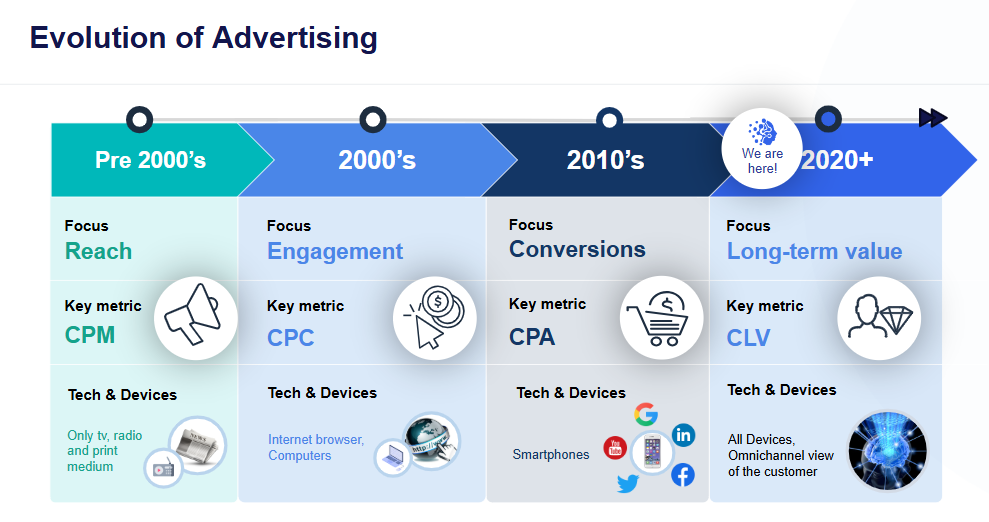An Evolving Advertising Landscape: Maximizing Customer Lifetime Value (CLV)
Customer lifetime value (CLV) is among the most critical metrics for businesses to track, representing the total revenue that can be expected from a customer over the course of their relationship. Advertising is an essential tool for maximizing CLV: Not only does it allow you to target and acquire high-value customers, but when used correctly, it can also foster long-term loyalty and engagement.
We are at a pivotal moment in the evolution of advertising, fueled by advances in Artificial Intelligence (AI). With the advent of tools like advanced algorithms and real-time offer delivery, we’re better able to present hyper-relevant offers to prospects and long-term customers alike, precisely how and when they want them.
To better understand the shift from traditional advertising strategies to today’s evolving landscape, let’s explore the journey that has led us to this new paradigm:
1. The Era of Impression-Based Ads (Pre-2000s)
In the early days of advertising, success was measured by impressions — the sheer number of times an ad was displayed. Advertisers paid for the potential reach of their messages, with media like print, radio, and television dominating the landscape. While this approach prioritized visibility, it often lacked deeper insights into performance or customer behavior. Instead, success was measured based on metrics like circulation numbers, viewer ratings, and listener statistics. Achieving outreach to broad audiences was considered a success, and advertising thus relied heavily on creative messaging that garnered mass appeal.
Data Insight:
A 1999 study by Nielsen found that the average click-through rate for display ads was around 2%. The focus remained on maximizing impressions, with limited tracking for actual engagement or ROI.
2. Click-Based Ads (2000s)
With the proliferation of internet access, the 2000s saw the rise of click-through rates (CTR) as a dominant metric. Platforms like Google Ads popularized pay-per-click (PPC) models, where advertisers only paid for actual user clicks. This innovation shifted the focus from impressions to measurable engagement, empowering businesses to directly track the effectiveness of their campaigns.
With the ability to target specific audiences using keywords, demographics, and user behaviors, click-based ads were highly appealing. They were also a cost-effective option available to a wide range of advertising budgets. The rise of performance analytics further fueled the model’s success and enabled advertisers to optimize campaigns quickly. This period lay the foundation for integrating data into advertising, setting the stage for the more sophisticated targeting that would come later.
Data Insight:
In 2002, Google Ads reported a 5% average CTR, but by 2010, this figure dropped to around 2%, indicating user saturation and diminishing returns.
3. Cost-Per-Acquisition Ads (2010s)
In the 2010s, Cost-Per-Acquisition (CPA) advertising became a cornerstone of performance marketing, shifting the focus from clicks to tangible outcomes, such as conversions and customer acquisitions. In this model, advertisers only paid when a specific action—such as a sign-up, download, or purchase—took place. This more nuanced approach enabled businesses to better align marketing spend with revenue generation.
The growth of CPA ads was fueled by advancements in tracking tools, including cookies, pixels, and sophisticated attribution models that allowed businesses to measure conversions with greater accuracy. Platforms like Facebook, Google, and affiliate networks capitalized on CPA by offering businesses tools to optimize campaigns for defined goals. For those seeking a clear ROI and reduced spending on unqualified leads, the approach was particularly appealing. The model’s precision also aligned with the growing importance of CLV, as marketers continued to set their sights on acquiring high-quality customers with lasting value.
Data Insight:
A 2015 survey by HubSpot found that businesses using CPA saw a 30% higher ROI compared to click-based models, as campaigns could be fine-tuned for conversions.

4. The Future: AI-Powered CLV Optimization
Now, thanks to advanced AI, we have entered an era in which advertising is optimized not just for clicks or acquisitions, but for maximizing CLV. This paradigm focuses on building long-term customer relationships and prioritizing high-value customers.
In our current competitive business landscape, optimizing CLV is critical to driving sustainable growth. While traditional marketing efforts focused on metrics like immediate sales or click-through rates, the shift toward CLV emphasizes long-term profitability. AI has revolutionized this approach, empowering businesses to optimize campaigns, target audiences with accuracy, and foster enduring customer relationships.
Why This Matters:
AI excels at processing vast amounts of data, with models that can analyze customer behavior, preferences, and historical data to predict future revenue from each customer segment. Its ability to uncover patterns in data and predict behaviors allows AI to identify high-value segments and forecast future purchasing potential. This in turn allows marketers to allocate advertising budgets more effectively, prioritizing efforts on acquiring and retaining customers with the highest lifetime value. Dynamic ad targeting ensures businesses focus on the most profitable audiences, and approaches like personalization can also be used to further nurture customer relationships.
Data Insight:
A 2023 report by McKinsey found that companies optimizing for CLV experienced a 20-40% increase in profitability compared to those using CPA models.
AI-driven personalization has been shown to boost customer retention by up to 15%.
